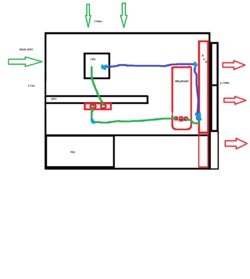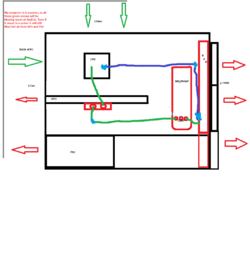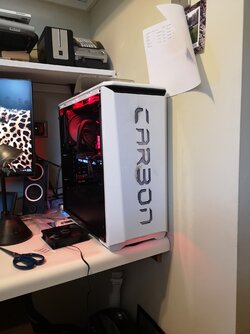-
Welcome to Overclockers Forums! Join us to reply in threads, receive reduced ads, and to customize your site experience!
You are using an out of date browser. It may not display this or other websites correctly.
You should upgrade or use an alternative browser.
You should upgrade or use an alternative browser.
New to water cooling, need some pointers on getting started.
- Thread starter infowire
- Start date
- Thread Starter
- #24
What temperature is the air inside the room set to?
gets hot up to 80F
- Joined
- May 22, 2011
- Location
- USA
I've seen a slight decrease in CPU temps when I go to the CPU first and than the GPU since the CPU is more sensitive.
The only set in stone rule is that the reservoir must feed the pump without interruption (i.e. no components between them). Utilizing a res/pump combo eliminates the possibility of error here.
Do people always use reservoir's now? Back in the day we had T lines for drain and fill...
- Joined
- May 22, 2011
- Location
- USA
Do people always use reservoir's now? Back in the day we had T lines for drain and fill...
It's much better to use a reservoir so it catches all the air pockets, let alone easier to fill and less worries of spills.
- Joined
- May 8, 2011
- Location
- Darlington, South Carolina
So like this :
View attachment 200832
then i have to get the thin radiator, http://www.xs-pc.com/radiators-tx-series/tx360-ultrathin-radiator
I run the opposite of what your drawing shows the rad exhausts out of the case and the top and rear are intakes, that way you are actually supplying a solid air flow to the VRs around your CPU socket, which will allow your M/B to run cooler. Motherboards are still designed with the traditional setup of the VRs surrounding the CPU socket which was supposed to be cooled by the stock air cooler. But today many CPUs are coming without stock air coolers and many are choosing the AIO setup, but never replacing the air flow the motherboard actually needs around the socket. Which forces the M/B to run hotter and shortens the lifespan of the motherboard.
When it comes to the initial installing of the O-ring G 1/4 fittings to your radiator, water blocks, and reservoir, most instructions tell you to install them finger tight, I always go finger tight plus and extra 1/4 turn tighter using a wrench, if you don't it will eventually back off from expansion and contraction. The ring that forces compression on the tubing itself you do install finger tight and check occasionally to make sure it stays finger tight.
Last edited:
- Thread Starter
- #32
- Joined
- May 8, 2011
- Location
- Darlington, South Carolina
Affirmative!
- Joined
- May 22, 2011
- Location
- USA
Well, you could go with that configuration but if you're worried about dust being caked on your stuff, you'll want front/bottom intake and top/rear as exhaust, assuming those intake areas are filtered plus you'll be feeding your rad with fresher air instantaneously.
Also, flipping the front rad so the ins/outs are at the top so any air pockets can exit that rad and eventually make their way to the reservoir would be recommended.
Also, flipping the front rad so the ins/outs are at the top so any air pockets can exit that rad and eventually make their way to the reservoir would be recommended.
- Joined
- May 22, 2011
- Location
- USA
Standard airflow is top/front intake as that's where the filters are usually and top/rear exhaust. If there's a filter at the top, turn it to intake as well since it'll be fighting against the filter and circulating that airflow up there. Everything else usually exhausts out the back via positive pressure.
well i see one problem .. the GPU blows heat to the back and the PSU. The back fan has no filter because its blowing out with the GPU and PSU.
View attachment 200930
Generally you are correct but in this application the GPU is water cooled and has no fans.
Also I agree with the consideration of filters. However, if your case has no intake filters or you are diligent with regular cleaning then fan orientation would be best the way SS suggested.
Similar threads
- Replies
- 2
- Views
- 1K
- Replies
- 49
- Views
- 6K


